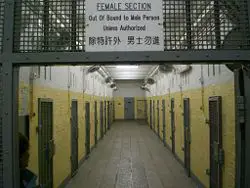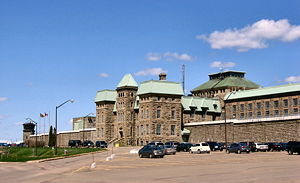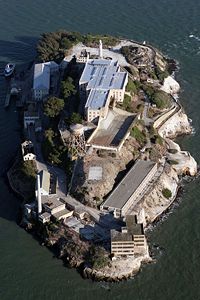Prison
A prison, penitentiary, or correctional facility is a place in which individuals are physically confined or interned, and usually deprived of a range of personal freedoms. Prisons are conventionally institutions that form part of the criminal justice system of a country, such that imprisonment or incarceration is a legal penalty or punishment that may be imposed by the state for the commission of a crime.
A criminal suspect who has been charged with or is likely to be charged with a criminal offense may be held "on remand" in prison if he or she is denied or unable to meet conditions of bail, or is unable to post bail. This may also occur where the court determines that the suspect is at risk of absconding before the trial, or is otherwise a risk to society. A criminal defendant may also be held in prison while awaiting trial or a trial verdict. If found guilty, a defendant will be convicted and may receive a custodial sentence requiring imprisonment.
Prisons may also be used as a tool of political repression to detain political prisoners, prisoners of conscience, and "enemies of the state," particularly by authoritarian regimes. In times of war or conflict, prisoners of war may also be detained in prisons. A prison system is the organizational arrangement of the provision and operation of prisons, and depending on their nature, may invoke a corrections system.
The prison system generally succeeds, despite some successful escapes from prisons, in the purposes of isolating criminals from society and punishing them for their crimes. However, rehabilitation is generally less easily achieved. In fact, those societies that focus on rehabilitation rather than severe punishment tend to have higher rates of recidivism. To be truly rehabilitated, all people need to understand their purpose in life, both as individuals and as citizens who contribute to the whole purpose of society, experiencing love and respect from others, so that they can have hope for happiness and fulfillment. These are not easy things to teach anywhere, let alone in a prison.
Other terms
There are a variety of other names for prisons, such as penitentiary or jail (in Australian and British English, the spelling gaol is sometimes used in formal contexts, although this spelling is pronounced in the same fashion).
In the 1790s, the Quakers in Pennsylvania coined the term penitentiary to describe a place for penitents who were sorry for their sins.[1] In the United States, "prison" or "penitentiary" typically denotes a place where inmates go to serve long terms after having been found guilty of a felony. The United States is one country where the term "jail" generally refers to facilities where detainees are locked up for a relatively short time (either while awaiting trial or serving a sentence of one year or less upon conviction for a misdemeanor). In the United States, jails are usually operated under the jurisdiction of local (county) governments while prisons are operated under the jurisdiction of state or federal governments. In the state of Massachusetts, some jails are known as "houses of correction" even though no actual âcorrectingâ takes place despite rehabilitation being mandated by Massachusetts state law. In Washington some adult prisons are called "reformatories," while in other states this is reserved as a term for a prison of the juvenile justice system. The term "correctional facility" has also been used.
History
The concept of prisons is an old one, but the modern prison system is relatively new. Today's prisons are designed with the idea that limitations on one's freedom are punishment enough for crimes committed. Before this idea came into play, punishment was typically physical in nature and took the form of torture or public humiliation. This transition from punishment to discipline occurred during the eighteenth and nineteenth centuries.
Some of this shift can be attributed to reformers who agitated for prisoner rights and the growing emphasis of the rights of individuals.
Prison reformers
John Howard is now widely regarded as the founding father of prison reform, having traveled extensively visiting prisons across Europe in the 1770s and 1780s. Also, the great social reformer Jonas Hanway promoted "solitude in imprisonment, with proper profitable labour and a spare diet."[2] Indeed, this became the popular model in England for many decades.
Within Britain, prison reform was spearheaded by the Quakers, and in particular, Elizabeth Fry during the Victorian era. Elizabeth Fry visited prisons and suggested basic human rights for prisoners, such as privacy and teaching prisoners a trade. Fry was particularly concerned with women's rights. Parliament, coming to realize that a significant portion of prisoners had come to commit crimes as a result of mental illness, passed the County Asylums Act (1808). This made it possible for Justice of the Peace in each county to build and run their own pauper asylums:
Whereas the practice of confining such lunatics and other insane persons as are chargeable to their respective parishes in Gaols, Houses of Correction, Poor Houses and Houses of Industry, is highly dangerous and inconvenient.[3]
In the United States, Dorothea Dix toured prisons in the U.S. and all over Europe looking at the conditions of the mentally handicapped. Her ideas led to a mushroom effect of asylums all over the United States.
In the early 1900s, Samuel June Barrows was a leader in prison reform. President Cleveland appointed him International Prison Commissioner for the U.S. in 1895, and in 1900 Barrows became Secretary of the Prison Association of New York and held that position until his death on April 21, 1909. A Unitarian pastor, Barrows used his influence as editor of the Unitarian Christian Register to speak at meetings of the National Conference of Charities and Correction, the National International Prison Congresses, and the Society for International Law. As the International Prison Commissioner for the U.S., he wrote several of todayâs most valuable documents of American penological literature, including âChildrenâs Courts in the United Statesâ and âThe Criminal Insane in the United States and in Foreign Countries.â As a House representative, Barrows was pivotal in the creation of the International Prison Congress and became its president in 1905. In his final role, as Secretary of the Prison Association of New York, he dissolved the associationâs debt, began issuing annual reports, drafted and ensured passage of New Yorkâs first probation law, assisted in the implementation of a federal parole law, and promoted civil service for prison employees. Moreover, Barrows advocated improved prison structures and methods, traveling in 1907 around the world to bring back detailed plans of 36 of the best prisons in 14 different countries. In 1910 the National League of Volunteer Workers, nicknamed the âBarrows Leagueâ in his memory, formed in New York as a group dedicated to helping released prisoners and petitioning for better prison conditions.
Prisons and the criminal justice system
A convicted defendant will typically receive a "custodial sentence" if found guilty of committing a serious criminal offense such as physical assault, rape, murder, and acts involving circumstances of aggravation (use of a weapon, violence, children), or has reoffended. In some countries, the law may require that courts hand down a mandatory and sometimes lengthy custodial sentence whenever a crime involves property, drugs, or other prohibited substances, or where the defendant has previously been convicted. Some jurisdictions may hold a suspect in prison on remand for varying periods of time.

The nature of prisons and of prison systems varies from country to country, although many systems typically segregate prisoners by sex, and by category of risk. Prisons are often rated by the degree of security, ranging from minimum security (used mainly for nonviolent offenders such as those guilty of fraud) through to maximum security and super-maximum or supermax (often used for those who have committed violent crimes or crimes while imprisoned).
The issue of crime and punishment is a highly politicized issue. Prisons, prison systems, sentencing and imprisonment practices, and the use of capital punishment may all lead to controversy and debate. For example, the use of mandatory sentencing and the effectiveness of custodial sentences for minor property crimes is often debated, especially where the prison sentence required in such cases is more harsh than for the commission of violent crimes.
Some of the goals of criminal justice are compatible with one another, while others are in conflict. In the history of prison reform, the harsh treatment, torture, and executions used for deterrence first came under fire as a violation of human rights. The salvation goal and methods were later attacked as violations of the individual's freedom of religion. This led to further "reforms" aimed principally at reform/correction of the individual, removal from society, and reduction of immediate costs. The perception that such reforms sometimes denied victims justice then led to further changes. The hope, in the future, is that medical diagnosis and treatments might assist future generations of prisoner reformers.
Purposes of prisons
Criminal justice models are based on the goals of the penal system:
Retribution/vengeance/retaliation

The notion of retribution and vengeance as the purpose of prison is founded on the "eye for an eye, tooth for a tooth" philosophy, or lex talionis, which essentially states that if one person harms another, then an equivalent harm should be done to them. One goal here is to prevent vigilantism, gang, or clan warfare, and other actions by those who have an unsatisfied need to "get even" for a crime against them, their family, or their group. It is, however, difficult to determine how to equate different types of "harm." A literal case is where a murderer is punished with the death penalty, the argument being "justice demands a life for a life."
One criticism of long-term prison sentences and other methods for achieving justice is that such "warehousing" of criminals is rather expensive. Another argument against warehousing rests upon the idea that any punishment considered respectful of human rights should not include caging humans for life without chance of releaseâthat even death is morally and ethically a higher road than no-parole prison sentences.
Deterrence
The idea of prisons as a deterrence involves the criminal being used as an "example to himself/herself and others." By subjecting prisoners to harsh conditions, authorities hope to convince them to avoid future criminal behavior and to exemplify for others the rewards for avoiding such behavior; that is, the fear of punishment will win over whatever pleasure the illegal activity might bring. The deterrence model frequently goes far beyond "an eye for an eye," exacting a more severe punishment than would seem to be indicated by the crime. Torture has been used in the past as a deterrent, as has the public embarrassment and discomfort of stocks, and, in religious communities, excommunication. Particularly gruesome executions (such as hanging, drawing and quartering, or beheading), often for petty offenses, are further examples of attempts at deterrence.
One criticism of the deterrence model is that criminals typically have a rather short-term orientation, and the possibility of long-term consequences is of little importance to them. Also, their quality of life may be so horrific that any treatment within the criminal justice system (which is compatible with human rights law) will only be seen as an improvement over their previous situation.
Reform/rehabilitation
With regards to the purpose of prisons, the purpose of reform or rehabilitation of prisoners, and the level of resources to apply to it are much disputed areas of public policy. One archaic school of thought is that a criminal should be encouraged to rehabilitate his or her inherent deficiencies. Alternatively, the process may be seen as providing the person with an alternative to criminal behavior upon release. This rehabilitation process may involve provision of education, vocational training, treatment for drug addiction, counseling, and/or an attempt to encourage socially acceptable behaviors: for instance the need to treat others with respect or the need for self-discipline might be stressed.
The approach to take with younger criminals, the severity of any regime, and whether efforts at rehabilitation should be mandatory are all areas of political debate, as is the issue of funding. While some argue that the cost to society is offset by preventing crime in the future, others contend that it rewards those in jail with training that would not otherwise have been available to them. A key issue that frames these debates is the view taken on responsibility for crime in society: are criminals inherently prone to illegal behavior, or does crime stem from a failure of social policy?
When reform and/or rehabilitation have failed, recidivism is a likely outcome. The United States maintains one of the highest recidivism rates in the world. With the number of U.S. inmates quadrupling since 1980, more human rights groups and other activist groups are working to reduce recidivism. Amnesty International works to protect the basic rights of inmates and the Innocence Project works to free wrongly convicted inmates. Even some businesses focus on reducing the extremely high rate of inmates returning to prison after they have been released by establishing positive relationships through letter writing.
Removal from society
The goal of removal from society is simply to keep criminals away from potential victims, thus reducing the number of crimes they can commit. The criticism of this model is that others increase the number and severity of crimes they commit to make up for the "vacuum" left by the removed criminal. For example, a drug dealer removed from a location will result in an unmet demand for drugs at that locale, and an existing or new drug dealer will then appear, to fill the void. This new drug dealer may have been innocent of any crimes before this opportunity, or may have been guilty of less serious crimes, such as being a lookout for the previous drug dealer.
Repayment
Prisoners are forced to repay their "debt" to society. Unpaid or low pay work is common in many prisons, often to the benefit of the community. Most of the time in prisons, low-pay work is a form of "keeping in touch" with the outside world and the jobs are ones that benefit the prison. For example, Monroe Prison in Monroe, Washington, is a fully self-sufficient facility. The prisonersâ jobs support the prison, such as laundry, yard maintenance, mechanical systems maintenance, and other jobs. The money made in these jobs goes to a prisoner account that the prisoner can access at any time. In some countries prisons operate as labor camps. Critics say that the repayment model gives government an economic incentive to send more people to prison. In corrupt or authoritarian regimes, many citizens may be sentenced to forced labor for minor breaches of the law, simply because the government requires the labor camps as a source of income. Community service is increasingly being used as an alternative to prison for petty criminals.
Reduction in immediate costs
Government and prison officials also have the goal of minimizing short-term costs.
In wealthy societies:
This calls for keeping prisoners "happy" by providing them with things like television and conjugal visits. Inexpensive measures like these prevent prison assaults and riots which in turn allow the number of guards to be minimized. Providing the quickest possible parole and/or release also reduces immediate costs to the prison system (although these may very well increase long-term costs to the prison system and society due to recidivism). The extreme method of reducing immediate costs is to eliminate prisons entirely and use fines, community service, and other sanctions (like the loss of a driver's license or the right to vote) instead. Executions at first would appear to limit costs, but, in most wealthy societies, the long appeals process for death sentences (and associated legal costs) make them quite expensive.
In poor societies:
Poor societies, which lack the resources to imprison criminals for years, frequently use execution in place of imprisonment, at least for severe crimes. Less severe crimes, such as theft, might be dealt with by less severe physical means, such as amputation of the hands. When long-term imprisonment is used in such societies, it may be a virtual death sentence, as the lack of food, sanitation, and medical care causes widespread disease and death, in such prisons.
Prison design and facilities

Male and female prisoners are typically kept in separate locations or prisons altogether. Prison accommodation, especially modern prisons in the developed world, are often divided into wings identified by a name, number, or letter. These wings may be further divided into landings that are essentially "floors" containing up to thirty cells. Cells are the smallest prison accommodation, each holding at least one or two prisoners. Cells which hold more than three or four prisoners may be known as dormitories. A building holding more than one wing is known as a "hall." Prisons generally have the following facilities:
- A main entrance, which may be known as the gatelodge or "Sally port."
- A chapel, which will often house chaplaincy offices and facilities for counseling of individuals or groups. Prisons may also contain a mosque or other religious facility.
- An education department, which may include a library, and which provides adult or continuing education opportunities for prisoners.
- At least one exercise yard, fenced areas that prisoners may use for recreational and exercise purposes.
- A healthcare facility or infirmary, which often includes a dentist.
- A segregation unit or "block," which is used to separate unruly, dangerous, or vulnerable prisoners from the general population. Inmates may be placed into segregation to maintain the safety and security of the institution, or the safety of any persons. Also, they may be segregated to preserve the integrity of an investigation, or when no other housing is practical.
- Vulnerable prisoners units (VPs), or Protective Custody (PC), used to accommodate prisoners classified as vulnerable, such as sex offenders, former police officers, and informants.
- Safe cells, used to keep prisoners under constant visual observation.
- Isolation cells, often referred to as "the hole" in some jurisdictions, used to keep prisoners completely isolated, usually as a punishment for misbehavior.
- Visiting rooms, where prisoners may be allowed restricted contact with relatives, friends, lawyers, or other people.
Other facilities that are often found in prisons include kitchens, gymnasiums, and accommodations for prison staff.
Prisons are normally surrounded by fencing, walls, earthworks, geographical features, or other barriers to prevent escape. Multiple barriers, concertina wire, electrified fencing, secured and defensible main gates, armed guard towers, lighting, motion sensors, dogs, and roving patrols may all also be present depending on the level of security. Remotely controlled doors, CCTV monitoring, alarms, cages, restraints, non-lethal and lethal weapons, riot-control gear and physical segregation of units and prisoners may all also be present within a prison to monitor and control the movement and activity of prisoners within the facility.
The "Panopticon" is a type of prison building designed by English philosopher Jeremy Bentham in the late eighteenth century. The concept of the design is to allow an observer to observe (-opticon) all (pan-) prisoners without the prisoners being able to tell if they are being observed or not, thus conveying a "sentiment of an invisible omniscience." In his own words, Bentham described the Panopticon as "a new mode of obtaining power of mind over mind, in a quantity hitherto without example."[4] While the design did not come to fruition during Bentham's time, it has been seen as an important development.
Modern prison designs, particularly those of high-security prisons, have sought to increasingly restrict and control the movement of prisoners throughout the facility while minimizing the corrections staffing needed to monitor and control the population. As compared to the traditional landing-cellblock-hall designs, many newer prisons are designed in a decentralized "podular" layout with individual self-contained housing units, known as "pods" or "modules," arranged around centralized outdoor yards in a "campus." The pods contain tiers of cells laid out in an open pattern arranged around a central control station from which a single corrections officer can monitor all of the cells and the entire pod. Control of cell doors, communications, and CCTV monitoring is conducted from the control station as well. Movement out of the pod to the exercise yard or work assignments can be restricted to individual pods at designated times, or else prisoners may be kept almost always within their pod or even their individual cells depending upon the level of security. Goods and services, such as meals, laundry, commissary, educational materials, religious services, and medical care can increasingly be brought to individual pods or cells as well.
Conversely, despite these design innovations, overcrowding at many prisons, particularly in the United States, has resulted in a contrary trend, as many prisons are forced to house large numbers of prisoners, often hundreds at a time, in gymnasiums or other large buildings that have been converted into massive open dormitories.
Lower-security prisons are often designed with less restrictive features, confining prisoners at night in smaller locked dormitories or even cottage or cabin-like housing while permitting them freer movement around the grounds to work or for activities during the day.
Types of prisons
Military and political prisons
Military prisons are operated by the military and used variously to house prisoners of war, enemy combatants, those whose freedom is deemed a national security risk by military or civilian authorities, and members of the military found guilty of a serious crime. Thus military prisons are of two types: penal, for punishing and attempting to reform criminals within the military, and confinement-oriented, where captured enemies are confined for military reasons until hostilities cease.
Certain countries maintain or have in the past had a system of political prisons; the gulag prison camps associated with Stalinism may be the best known. The definition of what is and is not a political crime and a political prison is, of course, highly controversial. Some psychiatric facilities have characteristics of prisons, especially when confining patients who have committed a crime and are considered dangerous.
Ecclesiastical prisons
The object of prisons originally, both among the Hebrews and the Romans, was merely the safekeeping of a criminal, real or pretended, until his trial. The ecclesiastical idea of imprisonment, however, is that confinement be made use of both as a punishment and as affording an opportunity for reformation and reflection. This method of punishment was anciently applied even to clerics. Thus, Boniface VIII (cap. "Quamvis," iii, "De poen.," in 6) decreed:
Although it is known that prisons were specially instituted for the custody of criminals, not for their punishment, yet we shall not find fault with you if you commit to prison for the performance of penance, either perpetually or temporarily as shall seem best, those clerics subject to you who have confessed crimes or been convicted of them, after you have carefully considered the excesses, persons and circumstances involved in the case.
It is plain from many decrees in the "Corpus Juris Canonici" that the Roman Catholic Church has claimed and exercised the right of protecting its members by condemning the guilty to imprisonment. The Church adopted the extreme punishment of perpetual imprisonment because, by the canons, the execution of offenders, whether clerical or lay, could not be ordered by ecclesiastical judges. It was quite common in ancient times to imprison in monasteries, for the purpose of doing penance, those clerics who had been convicted of grave crimes (c. vii, dist. 50). The "Corpus Juris," however, says (c. "Super His," viii, "De poen.") that incarceration does not of itself inflict the stigma of infamy on a cleric, as is evident from a papal pronouncement on the complaint of a cleric who had been committed to prison because he vacillated in giving testimony. The reply recorded is that imprisonment does not ipso facto carry with it any note of infamy.
As to monastic prisons for members of religious orders, they are found recorded in decrees dealing with the incorrigibility of those who have lost the spirit of their vocation. Thus, by command of Urban VIII, the Congregation of the Council (September 21, 1624) decreed:
For the future, no regular, legitimately professed, may be expelled from his order unless he be truly incorrigible. A person is not to be judged truly incorrigible unless not only all those things are found verified which are required by the common law (notwithstanding the constitutions of any religious order even confirmed and approved by the Holy See), but also, until the delinquent has been tried by fasting and patience for one year in confinement. Therefore, let every order have private prisons, at least one in every province.
Juvenile prisons
Prisons for juveniles are known as young offendersâ institutes and hold minors who have been convicted. Generally these are for people under age 18, but many countries have their own age of criminal responsibility in which children are deemed legally responsible for their actions for a crime.
Juveniles are kept out of the main correctional system for a number of reasons. One is the fear of falling into a cycle of criminality as a result of exposure to the main prison population. Another fear is that young prisoners would be exploited for sexual or violent activity. Juvenile facilities are traditionally more focused on rehabilitation than other prisons.
Notes
- â George B. Vold, Thomas J. Bernard, and Jeffrey B. Snipes, Theoretical Criminology (Oxford University Press, 2001, ISBN 0195142020).
- â Jonas Hanway, Solitude in Imprisonment: With Proper Profitable Labour and a Spare Diet (Gale ECCO, 2010, ISBN 978-1171444800).
- â Andrew Roberts, George 3, c.96 1808 County Asylums Act Table of Statutes. Retrieved June 20, 2020.
- â Jeremy Bentham, The Panopticon Writings (London: Verso, 2011, ISBN 978-1844676668).
ReferencesISBN links support NWE through referral fees
- Applebaum, Anne. Gulag: A History. Anchor, 2004. ISBN 1400034094
- Bentham, Jeremy. The Panopticon Writings. London: Verso, 2011. ISBN 978-1844676668
- Christianson, Scott. Notorious Prisons: An Inside Look at the World's Most Feared Institutions. Lyons Press, 2004. ISBN 1592285821
- Davis, Angela. Are Prisons Obsolete? Seven Stories Press, 2003. ISBN 1583225811
- Foucault, Michel. Discipline & Punish: The Birth of the Prison. Vintage, 1995. ISBN 0679752552
- Hanway, Jonas. Solitude in Imprisonment: With Proper Profitable Labour and a Spare Diet. Gale ECCO, 2010. ISBN 978-1171444800
- Morris, Norval. The Oxford History of the Prison: The Practice of Punishment in Western Society. Oxford University Press, 1995. ISBN 0195061535
- Parenti, Christian. Lockdown America: Police and Prisons in the Age of Crisis. Verso, 2000. ISBN 1859843034
- Ross, Jeffrey. Behind Bars: Surviving Prison. Alpha, 2002. ISBN 0028643518
- San Quentin Prison, Established 1852: 150th Anniversary Commemorative Book. Turner Publishing, 2002. ISBN 1563118130
- Vold, George B., Thomas J. Bernard, and Jeffrey B. Snipes. Theoretical Criminology. Oxford University Press, 2001. ISBN 0195142020
- Wachsmann, Nikolaus. Hitler's Prisons. Yale University Press, 2004. ISBN 030010250X
- Wituska, Krystyna. Inside a Gestapo Prison: The Letters of Krystyna Wituska, 1942â1944. Wayne State University Press, 2006. ISBN 0814332943
External links
All links retrieved November 30, 2022.
- Prisons and probation Ministry of Justice, UK.
- Inside: Russia's Toughest Prisons National Geographic.
Credits
New World Encyclopedia writers and editors rewrote and completed the Wikipedia article in accordance with New World Encyclopedia standards. This article abides by terms of the Creative Commons CC-by-sa 3.0 License (CC-by-sa), which may be used and disseminated with proper attribution. Credit is due under the terms of this license that can reference both the New World Encyclopedia contributors and the selfless volunteer contributors of the Wikimedia Foundation. To cite this article click here for a list of acceptable citing formats.The history of earlier contributions by wikipedians is accessible to researchers here:
The history of this article since it was imported to New World Encyclopedia:
Note: Some restrictions may apply to use of individual images which are separately licensed.






